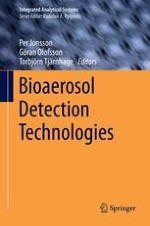2014 | OriginalPaper | Chapter
13. Spectrally Resolved Laser-Induced Fluorescence Lidar Based Standoff Biodetection System
Authors : Jean-Robert Simard, Sylvie Buteau, Pierre Lahaie
Published in: Bioaerosol Detection Technologies
Publisher: Springer New York
Activate our intelligent search to find suitable subject content or patents.
Select sections of text to find matching patents with Artificial Intelligence. powered by
Select sections of text to find additional relevant content using AI-assisted search. powered by
